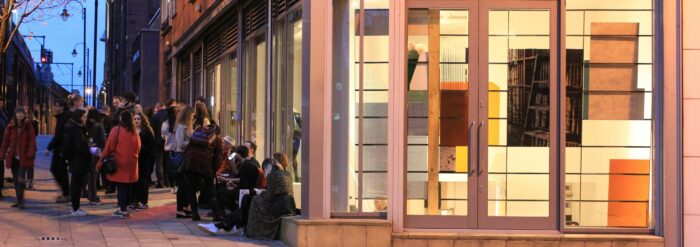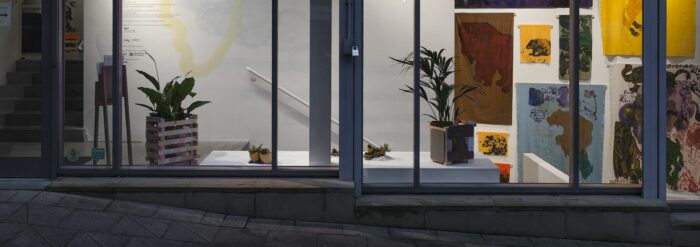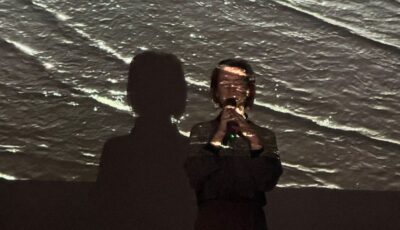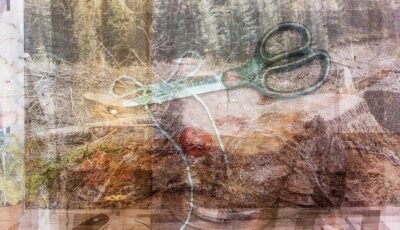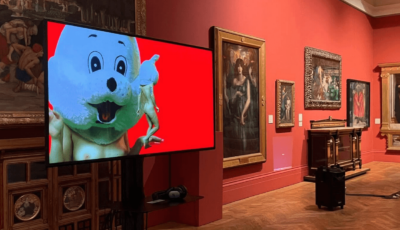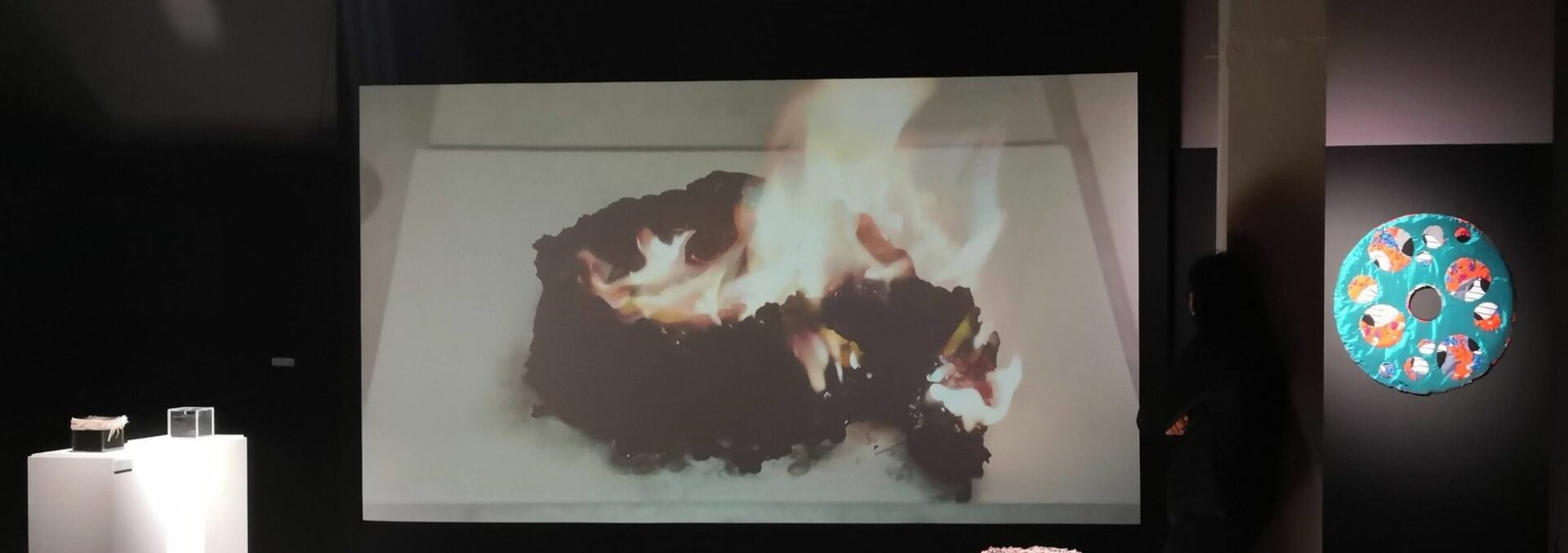
Spotlight: Artists and Sustainability – Adele Jordan
Posted on 22 May 2024
This month we’ve invited Adele Jordan to contribute to our ongoing series Spotlight – Artists and Sustainability, where we ask artists to share short responses about their work and how it might relate to climate change.
Adele graduated from MMU in 2022 with a Distinction in MA Textiles. Since then she has exhibited 3 times as a Green Grad in London & Manchester (2022 & 2023) and at Air Gallery, Altrincham, in their group show Fibre in 2023. Most recently she exhibited in SPARK: artist interventions in a time of crisis at Rogue Artist Studios 2023/2024. She was shortlisted for the Manchester Open 2024 Castlefield Gallery Development Awards.
Adele’s background is as a printmaker, who taught both in FE and HE over a 9 year period from 1994-2003. She introduced non-toxic printmaking into Blackburn College and utilised wasted shop window cardboard signage and old commercial litho plates as her main teaching resource to print from. She also has an MA in Gallery Studies from the University of Essex.
In what ways do you feel your work might relate to issues of climate change and sustainability, in the content of the work, its narrative, conceptually or theoretically. How might it speak to or challenge public discourse?
Having set up and run a social enterprise, Cracking Good Food, for 10 years, that helped communities to connect to local, sustainable food production and cooking, my artwork within the textile system deals exclusively with the same issues. These of course are models by which corporations produce both food and clothing en masse, for maximum profit, with complete disregard for workers’ rights and the environmental damage such quantities of production and waste create.
My textile work aims to tackle these issues head-on, as fast fashion and its supply chain now account for the third largest polluting industry, after food and construction. Our capitalist model drives this insatiable consumption, yet it is the increasing production of synthetic, oil derived fibres, which now account for 69% of all textiles which is the most concerning, if we are to wean ourselves off fossil fuels. Working with a Material Scientist, I undertook a form of reverse alchemy to determine a fabric’s oil content. Similarly, I directly melted garments to starkly reveal just how much plastic people are now wearing.
My film Fabric of Oil reveals the reverse alchemy process, whilst the textile doughnuts symbolise Kate Raworth’s much needed economic model which defines our ecological ceiling, beyond which we must not live, which we are. I make use of infographics and plastiglomerates, which is the name now given by geologists to classify a newly identified rock formation containing plastic. In addition I have produced terrariums containing both oil and regenerative flax, symbolising our polarised textile system.
With regards to the materials, processes and techniques you use to produce your work, are there any practical decisions you make with regard to climate change and sustainability
My work is almost exclusively created using found, wasted materials. Excessive wastage is due to over-consumption and built-in obsolescence, thereby reducing options to repair. I would therefore personally feel very uncomfortable using anything but, although it is of course very much the subject of my work. Waste, quite simply though, is the new resource. For me, it’s a moral imperative. I volunteered for some time at Barnardos distribution centre and was appalled by how much was received on an hourly basis but equally became aware too of the many items that they did not accept, like duvets. This prompted further research into the levels of their wastage across Manchester’s recycling centres which subsequently developed into an installation piece Discarded Potential comprising of statistics, duvets, oil and a repurposed duvet.
For me, given that artists are creative thinkers, it’s almost incomprehensible that one would choose to purchase materials from an Amazon type warehouse instead. I know it would appear to be a radical change for some, but the alternative of just sticking with the same old is simply damaging our planet and we need to adjust, urgently. For some it might just be that they’d not thought of it in that way, which is totally understandable, so learning more about our impact and how we can adapt is critical. We all know the power of voting with ones’ feet, having seen and experienced many businesses fail due to reduced customers. There are so many sustainable, positive alternatives, it’s just a case of finding it. And it’s certainly true treasure (and often free or certainly far cheaper) when found!
“The really big resources of the future are the landfill sites, which are enormous …. kilometres across, thousands of metres deep. They contain metals, plastics, human-made and organic material in the most incredible mixtures.. not at all present anywhere in the natural world. Physically, chemically and biologically we are creating something quite alien to the earth.”
Prof Jan Zalasiewicz, geologist and Professor of Palaeobiology at the University of Leicester
In general, how do you feel galleries, art spaces, artworks and artists, might be able to contribute, what if any role do you feel they can play in a progressive conversation.
I think that collaboration is key on every level whether that be through galleries and collectives or with those from other fields of enquiry. Working together is an inclusive position by which we can unite to make positive change, benefiting from each other’s knowledge and experience, both through our practise and future vision. Most importantly perhaps it provides an opportunity to lead by example, encouraging others to join and transition to a different perspective as both a way of working and being. If we all stood together linking arms, wouldn’t we all feel so much more a part of a movement pushing for positive change?
Are there any tips or advice, anything you have learnt you might want to share with other artists or our audience
I’ve learnt to be bolder and prouder of my sustainable position whereas in the past I perhaps concealed some of my more activist approach. And I’m far more open to challenging the norm now, as long as it’s done gently and kindly, as opposed to silently rolling my eyes and letting it be. The old fashioned linear system is based on Take, Make, Use and Lose, which our planet can no longer sustain. We have gone beyond our boundaries, we’re at a tipping point and should seriously only source our materials now from the Use point in order to instil a circular system. It’s not rocket science! It’s just about a change in mindset and values, but that can only be a good thing. There is so much potential in doing the right thing. Be that change. It’ll be the making of you and our planet.
Key Books:
– Less is More. How de-growth will save the world. Hickel, Jason. 2020.
– Doughnut Theory. Seven ways to think like a 21st century economist. Raworth, Kate. 2017.
– Fibreshed. Growing a movement of farmers, fashion activists and makers for a new textile economy. Burgess, Rebecca. 2019
– Worn. A people’s history of clothing. Thanhauser Sofi. 2021.
– Why Materials Matter. Responsible Design for a Better World. Solanki, Seetal. 2021.
– Radical Matter. Rethinking Materials for a Sustainable Future. Franklin, Kate & Till, Caroline. 2018.
Key reports /leading NGOs:
– Changing Markets Foundation | Ellen MacArthur Foundation.
– Fast Fashion Statistics. Key elements of the above, and more, have been referenced in my 20 page zine which I wrote and hand printed as part of my MA providing an immediate summary of the issues.
